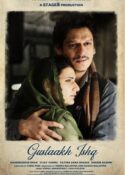 Anurag Kashyap’s latest film, That Girl in Yellow Boots, is a stylish, provocative thriller that has been well received by audiences at both the Venice and Toronto International Film Festivals. It’s the story of “England Girl” Ruth (Kalki Koechlin) who has come to India, like so many Westerners before her, on a quest. But where many set out in search of spirituality, Ruth wants to find her Indian father who left her and her mother many years earlier, after the suicide of her sister. And, unfortunately, like too many Westerners who come to India without work permits, Ruth finds herself working in a massage parlour – giving clients a “happy ending” for an extra 1000 rupees – just to make ends meet and to grease the wheels of bureaucracy in order to find out the information she needs.
Anurag Kashyap’s latest film, That Girl in Yellow Boots, is a stylish, provocative thriller that has been well received by audiences at both the Venice and Toronto International Film Festivals. It’s the story of “England Girl” Ruth (Kalki Koechlin) who has come to India, like so many Westerners before her, on a quest. But where many set out in search of spirituality, Ruth wants to find her Indian father who left her and her mother many years earlier, after the suicide of her sister. And, unfortunately, like too many Westerners who come to India without work permits, Ruth finds herself working in a massage parlour – giving clients a “happy ending” for an extra 1000 rupees – just to make ends meet and to grease the wheels of bureaucracy in order to find out the information she needs.
Ruth arrives in India with one clue: a letter her father has sent her. From that one clue, she must investigate and navigate a system that includes sleazy local bureaucrats and a bunch of South Indian drug dealers – all of whom want a piece of her, in the most cynical sense of that phrase. They have power over her: power to renew her visa (or not), power to give her more clues to her father’s whereabouts, power to withhold what they know or to simply ignore her requests. They have the power to take her money, and then insist on hand-jobs to pay off the rest of her coke-addled boyfriend’s debt.
That Girl in Yellow Boots is an unflinching film. At a post-screening Q&A session at the Toronto International Film Festival, the film’s writers, director Kashyap and actor Koechlin, suggested that the film tackles a subject that the tends to be brushed off by Indian officials, and presents a hauntingly gritty and realistic view of a side of India rarely dealt with in mainstream Indian cinema. Anurag Kashyap is no stranger to controversial, difficult subjects, and That Girl in Yellow Boots continues in a series of films (Black Friday, No Smoking, Dev.D) that take challenging ideas and infuse them with modern sensibility and stylish, thoughtful, well-crafted filmmaking. More than that: That Girl in Yellow Boots tackles material that, in the hands of a lesser director than the immensely talented Anurag Kashyap, might easily have ended up being voyeuristic or vulgar. That Girl in Yellow Boots is neither, even when it makes us distinctly uncomfortable.
Much credit for that, too, goes to Kalki Koechlin’s performance – her Ruth is layered, resourceful and determined, yet naive and vulnerable at her core, and Koechlin brings force and a luminous grace to her portrayal. Ruth does what she needs to do to get what she wants, no matter how distasteful one might think it is. She is often at the mercy of a system bent on using her; but she also takes control where she can: working on improving her Hindi (language is power for those who master it – this is revealed when Ruth tells off a taxiwalla using the colourful language she’s learned from the other girls at the massage parlour), or manipulating the story of the death of the father of the South Indian thug for her own ends, upsetting him so much he no longer wants the “happy ending” he’s insisted she give him to pay for her boyfriend’s debts.
 In a film filled with interesting performances at every level, Prashant Prakash, too, stands out as Ruth’s shady boyfriend, Prashant. Theirs is a troubled relationship: “You behave as though you’re immaculate,” Prashant snarls at her at one point, emphasizing how Ruth holds herself emotionally unavailable for everyone, including Prashant. Prashant wants to have sex with her; Ruth only wants to treat him like one of her clients. When Prashant decides to go cold turkey, chaining himself to a window and going through all the pains of drug withdrawal, he accuses Ruth of wrapping her emotions up in a kind of saintliness, of holding onto her suffering as something special and unique. And although it would be easy to see Prashant as just one more person who wants to use Ruth for his own needs, the diatribe he launches at her in the midst of his own struggle contains a grain of truth. Prashant may not love Ruth unconditionally, but he does care for her, as the film’s final scenes serve to underline, and the actor takes Prashant and adds depth and nuance and heartbreaking honesty to a character we first see as merely superficial and sleazy.
In a film filled with interesting performances at every level, Prashant Prakash, too, stands out as Ruth’s shady boyfriend, Prashant. Theirs is a troubled relationship: “You behave as though you’re immaculate,” Prashant snarls at her at one point, emphasizing how Ruth holds herself emotionally unavailable for everyone, including Prashant. Prashant wants to have sex with her; Ruth only wants to treat him like one of her clients. When Prashant decides to go cold turkey, chaining himself to a window and going through all the pains of drug withdrawal, he accuses Ruth of wrapping her emotions up in a kind of saintliness, of holding onto her suffering as something special and unique. And although it would be easy to see Prashant as just one more person who wants to use Ruth for his own needs, the diatribe he launches at her in the midst of his own struggle contains a grain of truth. Prashant may not love Ruth unconditionally, but he does care for her, as the film’s final scenes serve to underline, and the actor takes Prashant and adds depth and nuance and heartbreaking honesty to a character we first see as merely superficial and sleazy.
The irony, of course, is that Ruth’s own single-minded devotion to her quest has blinded her not only to Prashant’s suffering, but also to the one person in her life who does, in fact, truly care for her. Veteran Naseerudin Shah brings warmth and humour to Diwakar, the older client who comes to have his legs massaged. Diwakar is the one person who talks to Ruth and lets her talk (everyone else in Ruth’s life asks her, more or less, to shut up), who encourages her, and who is incensed to discover the final “handshake” she gives some of her customers.
In a scene early in the film, Ruth is watching an elderly guru on television, and she hits the pause button just after he advises: “Accept this: there is no enlightenment.” It’s a powerful statement on the nature of shady gurus (of any religion) who prey on those who are suffering – and is inspired by similar stories Kashyap read in the news. But it’s also a message to Ruth, who thirsts for details of her father, simply because, as she tells her boyfriend, she wants one person in her life who will love her, without wanting something from her, unconditionally.
Ultimately, the enlightenment Ruth eventually attains is not what she expected – her investigation opens a kind of Pandora’s box, and as with that mythical device, once the evil is released from the box, it cannot be put back in. Like so much in Ruth’s life, enlightenment is just one more thing that comes with a price. The mystery for the viewer is to discover what that price is.








